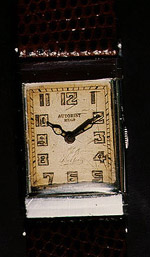Kingmatic
Habitual
Sin verificar
Hola Cuates con motivo de mi post número 1000!!! me puse a pensar en cómo celebrarlo y lo que se me ocurrió para agradecer toda la paciencia, sapiencia y camaradería en este foro de RE y particularmente con los "cuadernos" del subforo vintages ,fue el de generar un hilo sobre un tema inédito (o al menos uno que no se haya hablado hasta la saciedad).
En fin que tras pensarle un rato, me decidí por hablar sobre un reloj (no podía ser de otro modo) que adquirí (sin querer queriendo) hace un par de semanas. Este relojito (y lo digo en sentido literal) , me "robó" el corazón desde que posé mis ojillos en el. Y es que al tomarlo en mis manos me llamaron la atención principalmente dos cosas: la primera que ! no tenía corona ! y la segunda la marca ¿Harwood ?
Me suena , me suena me dije , donde lo he oído y de repente EUREKA!! claro, si es ni más ni menos un precioso ejemplar del primer reloj automático (o al menos eso había leído). Ni tardo ni perezoso, lo aparté y una vez llegado a casa me dediqué a buscar y rebuscar cuanta información pude colectar . No quiero aburrirlos con todos los detalles , ya que al ser un reloj histórico abundan los datos y estos se pueden encontrar en la Web o la muchos de los libros sobre relojes de pulsera.
De todas ellas y cómo soy medio producto de gallina en grado superlativo para escribir estas reseñas, sólo me limitaré a copiar una de ellas que me parece contiene los datos más relevantes y agregar algunas fotos y recortes de imágenes que preparé para ilustrar el punto.
John Harwood Inventor of Self Winding (Automatic) Wrist Watches
The idea of automatic winding dates back to the 1770's when it was first tried out by Swiss watchmaker Abram-Louis Perrelet (1729-1826), but it was first applied to wristwatches by John Harwood (1893-1964) in 1922.
Harwood, a watchmaker of Bolton, Lancashire, had for some years, before taking out his patent of 1924, considered the possibility and the advantages of automatic winding. These advantages include the improved maintenance of the balance amplitude, through the continuously wound state of the mainspring, and the exclusion of dirt by dispensing with the winding stem. The weight, which was to be oscillated by the movement of the wrist and so wind the spring, was, in the early experiments, pivoted near the edge of the movement after the manner of Breguet. This arrangement proved unsatisfactory and the weight was then pivoted at the centre of the movement. This position is now accepted by many makers as the most satisfactory. The hands were set by rotating the knurled bezel and so the stem was eliminated.
Harwood took his watch to Switzerland with the hope of persuading Swiss manufacturers to produce it in quantity. The Swiss, with a conservatism that rivalled that of the early English makers, saw no future for the invention, and Harwood returned disappointed to England.
Back in England he had the good fortune to secure enough capital to cover the cost of tools and labour for a new effort to start manufacture and, thus ensured against financial loss, the firm of A. Schild S.A. of Switzerland undertook the manufacture of the watch. Its production entailed many problems which Harwood's application and energy eventually overcame. This effort culminated in his personal assembly of the first three dozen movements. With success in the venture seeming certain, factories were established in France and America, with a head office in London. It was a cruel blow to a spirited and determined enterprise when the world trade slump of 1931 caused the company to cease activities.
The Autorist wristwatch, an earlier invention by Harwood, relied upon the movement of the wrist, causing the strap to pull against a pivoted retainer, in turn connected to a lever within the movement which kept the mainspring fully wound. Not as successful as his later invention, it was never developed further.
John Harwood was awarded the Gold Medal of the British Horological Institute in 1957 for his development of the automatic watch. He died in August 1964.
Ok , aquí habrá más de uno que seguro querrá añadir información: que si Fortis , que si Blancpain, que si hubo otros antes , que si Rolex , que si esto que si lo otro. Así que dejo a ustedes la tarea de enriquecer con su sabiduría este hilo para deleite de todos aquellos que cómo un servidor gustan de la historia de los relojes y de los relojes con historia.
Finalmente pongo un par de fotos de mi ejemplar y esperaré sus comentarios y críticas

Verdad que no me equivoqué al decir que era un relojito?
Luego un acercamiento para mostrar detalles de la carátula , por cierto para los que se andarán preguntando ¿cómo se pone la hora?, pues hay que decir que es super fácil , pues el bisel se gira hasta que el punto rojo se vea claro , luego se comienza a girar hasta alcanzar la hora deseada y luego se gira en sentido inverso hasta que el punto se vea rojo y Voilá!!

Por último lo más importante y lo por lo que es famoso, la maquinaria bumper de 17 joyas (dejo un esquema del mismo obtenido de la copia de la patente original inglesa de 1923). Aquí también he de decir que he visto fotos de algunos en la Web (e.g. en Antiquorum, Christies o Sotheby´s) y de sus máquinas (algunas muy fregadas). La mía parece de los modelos "recientes" ¿finales de los 30´s? está en muy buen estado hoy lo probé y funcionó de maravilla.

Un gran abraz a todos y vamos por más....
a todos y vamos por más....
En fin que tras pensarle un rato, me decidí por hablar sobre un reloj (no podía ser de otro modo) que adquirí (sin querer queriendo) hace un par de semanas. Este relojito (y lo digo en sentido literal) , me "robó" el corazón desde que posé mis ojillos en el. Y es que al tomarlo en mis manos me llamaron la atención principalmente dos cosas: la primera que ! no tenía corona ! y la segunda la marca ¿Harwood ?
Me suena , me suena me dije , donde lo he oído y de repente EUREKA!! claro, si es ni más ni menos un precioso ejemplar del primer reloj automático (o al menos eso había leído). Ni tardo ni perezoso, lo aparté y una vez llegado a casa me dediqué a buscar y rebuscar cuanta información pude colectar . No quiero aburrirlos con todos los detalles , ya que al ser un reloj histórico abundan los datos y estos se pueden encontrar en la Web o la muchos de los libros sobre relojes de pulsera.
De todas ellas y cómo soy medio producto de gallina en grado superlativo para escribir estas reseñas, sólo me limitaré a copiar una de ellas que me parece contiene los datos más relevantes y agregar algunas fotos y recortes de imágenes que preparé para ilustrar el punto.
John Harwood Inventor of Self Winding (Automatic) Wrist Watches
The idea of automatic winding dates back to the 1770's when it was first tried out by Swiss watchmaker Abram-Louis Perrelet (1729-1826), but it was first applied to wristwatches by John Harwood (1893-1964) in 1922.
Harwood, a watchmaker of Bolton, Lancashire, had for some years, before taking out his patent of 1924, considered the possibility and the advantages of automatic winding. These advantages include the improved maintenance of the balance amplitude, through the continuously wound state of the mainspring, and the exclusion of dirt by dispensing with the winding stem. The weight, which was to be oscillated by the movement of the wrist and so wind the spring, was, in the early experiments, pivoted near the edge of the movement after the manner of Breguet. This arrangement proved unsatisfactory and the weight was then pivoted at the centre of the movement. This position is now accepted by many makers as the most satisfactory. The hands were set by rotating the knurled bezel and so the stem was eliminated.
Harwood took his watch to Switzerland with the hope of persuading Swiss manufacturers to produce it in quantity. The Swiss, with a conservatism that rivalled that of the early English makers, saw no future for the invention, and Harwood returned disappointed to England.
Back in England he had the good fortune to secure enough capital to cover the cost of tools and labour for a new effort to start manufacture and, thus ensured against financial loss, the firm of A. Schild S.A. of Switzerland undertook the manufacture of the watch. Its production entailed many problems which Harwood's application and energy eventually overcame. This effort culminated in his personal assembly of the first three dozen movements. With success in the venture seeming certain, factories were established in France and America, with a head office in London. It was a cruel blow to a spirited and determined enterprise when the world trade slump of 1931 caused the company to cease activities.
The Autorist wristwatch, an earlier invention by Harwood, relied upon the movement of the wrist, causing the strap to pull against a pivoted retainer, in turn connected to a lever within the movement which kept the mainspring fully wound. Not as successful as his later invention, it was never developed further.
John Harwood was awarded the Gold Medal of the British Horological Institute in 1957 for his development of the automatic watch. He died in August 1964.
Ok , aquí habrá más de uno que seguro querrá añadir información: que si Fortis , que si Blancpain, que si hubo otros antes , que si Rolex , que si esto que si lo otro. Así que dejo a ustedes la tarea de enriquecer con su sabiduría este hilo para deleite de todos aquellos que cómo un servidor gustan de la historia de los relojes y de los relojes con historia.
Finalmente pongo un par de fotos de mi ejemplar y esperaré sus comentarios y críticas
Verdad que no me equivoqué al decir que era un relojito?
Luego un acercamiento para mostrar detalles de la carátula , por cierto para los que se andarán preguntando ¿cómo se pone la hora?, pues hay que decir que es super fácil , pues el bisel se gira hasta que el punto rojo se vea claro , luego se comienza a girar hasta alcanzar la hora deseada y luego se gira en sentido inverso hasta que el punto se vea rojo y Voilá!!
Por último lo más importante y lo por lo que es famoso, la maquinaria bumper de 17 joyas (dejo un esquema del mismo obtenido de la copia de la patente original inglesa de 1923). Aquí también he de decir que he visto fotos de algunos en la Web (e.g. en Antiquorum, Christies o Sotheby´s) y de sus máquinas (algunas muy fregadas). La mía parece de los modelos "recientes" ¿finales de los 30´s? está en muy buen estado hoy lo probé y funcionó de maravilla.
Un gran abraz
 a todos y vamos por más....
a todos y vamos por más....



 .
.



 :
: